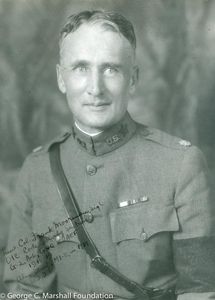"On This Date in Cryptologic History" Calendar
1917: Capt Frank Moorman tasked to form Radio Intelligence Section.

28 July 1917: Capt Frank Moorman was tasked by AEF G2, Brig. Gen. Dennis Nolan to form a new Radio Intelligence Section with the mission of reading German code and deciphering messages. Photo via the George C. Marshall Foundation.
Learn more via the article included below, "Tactical Signals Intelligence Originates in World War I," by Ruth Quinn
"Tactical Signals Intelligence Originates in World War I July 1917"
By Ruth Quinn, Staff Historian
USAICoE Command History Office
On July 28, 1917, the American Expeditionary Forces G2, Brigadier General Dennis Nolan, tasked Captain Frank Moorman, a Coast Artillery officer, to form a new Radio Intelligence Section under the General Staff. Moorman understood that the mission of the new Section was to read German code and decipher messages, but that was where his guidance ended. He had to form the section and begin work without the benefit of training, an after action report or a standard operating procedure. How this intelligence was to be collected and deciphered was still unknown. For almost two months, Captain Moorman worked alone, studying British and French methods, and consulting with the Signal Corps, who also operated their own Radio Intelligence Section. He was eventually joined in September by First Lieutenant H.A. Berthold, another Coastal Artillery officer, and in October by Army Field Clerk Harry Block.
Moorman was able to gain access to an area in the vicinity of the Meuse River in order to set up a few intercept stations. He needed to be able to collect raw traffic so he and his men could practice the decoding methods they had been learning from their allies. In addition, he worked a deal with the Signal Corps to furnish men and instruments to intercept messages and relay them to the new Section. The first messages were intercepted on October 29, 1917 by the American station at Gondrecourt, but these were few in number, since the station was so far from the front. To frustrate the new section even more, considerable time was dedicated to decoding these first messages, under the belief that they were of German origin. In fact, they were meaningless practice messages transmitted by stations attached to the American School at Langres. The Radio Intelligence Section boys were off to a rocky start.
It wasn’t long, however, before the efficiency of the personnel increased, creating greater volume. On November 12, 1917, a station in Souilly opened with one sergeant and eight men from the Second Field Signal Battalion. In the first month of continuous 24-hour operation, the station recorded a total of 393 messages and 1,173 calls which were turned over to the RIS for training purposes. From that point on, it became standard for all new intercept operators to first receive training at the schools at Langres and Gondrecourt and then be placed as close to the front line as practicable for their advanced training.
The two operators at the intercept station at General Headquarters recorded and turned over to the RIS, General Staff, an average of 15 messages and seven press reports a day during the month of November 1917. From the date the first intercept was received, messages came in so fast that the tiny staff of the RIS, General Staff, were unable to handle them all, and it soon became necessary to enlarge the section. Officers and clerks were therefore obtained from all available sources. In the case of officers, a search was made for men of high mental caliber who also knew German. This proved to be a challenge, as Moorman wrote in his final report, “The difficulty experienced in finding men who could actually think without a guardian was surprising. It is to be hoped that one of the aims of the future will be to develop this ability in men chosen for code and cipher work.”
Between its start on July 28, 1917, and Lt. Col. Moorman’s final report dated January 2, 1919, a total of eighty personnel were members of the General Staff Radio Intelligence Section at one time or another, including Captain Herbert O. Yardley, who later headed the Army’s code and cipher bureau and the State Department’s Black Chamber, and First Lieutenant William F. Friedman, who would later head the Army’s Signal Intelligence Service.
In 1920, Lt. Col. Moorman spoke about the difficulties of his task during the tumultuous build-up of the First World War to the officers of the Military Intelligence Division of the General Staff:
“One is the difficulty in getting men who are trained in the work. General Nolan expressed the situation very well toward the latter part of the war when he said that he started in with a misconception of what was required. He said that the next time he would put into this work the best brains of the country. He also admitted that he had not appreciated the importance of the code and cipher work…Next, we lacked liaison with Washington. I do not think that Washington understood our problems in the beginning. We did not understand Washington, and did not make any particular effort to appeal to them for help.”
The men of the Radio Intelligence Service, General Staff located enemy radio stations, constructed net diagrams, intercepted and decoded enemy radio and telegraph messages and telephone conversations, intercepted and located radio signals from airplanes ranging for hostile artillery, policed American telephone lines near the front operational security, and distributed American trench codes. Moorman and his section were in the forefront of the American Army’s first foray into tactical signals intelligence.
Source: SRH-001 Historical Background of the Signal Security Agency, Volume II, World War I, prepared under the direction of the Assistant Chief of Staff, G-2, 12 April 1946, in USAICoE archives.


